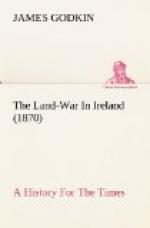The commissioners next sat at Strabane, a town within two or three miles of Lifford, where a similar jury was empanelled for the county Tyrone, to try O’Neill. One of the counts against him was that he had treasonably taken upon him the name of O’Neill. In proof of this a document was produced: ‘O’Neill bids M’Tuin to pay 60 l.’ It was also alleged that he had committed a number of murders; but his victims, it was alleged, were criminals ordered for execution in virtue of the power of life and death with which he had been invested by the queen. He was found guilty, however; and Henry Oge O’Neill, his kinsman, who was foreman of the jury, was complimented for his civility and loyalty, although he belonged to that class concerning which Sir John afterwards wrote, ’It is as natural for an Irish lord to be a thief as it is for the devil to be a liar, of whom it was written, he was a liar and a murderer from the beginning.’
True bills having been found by the grand juries, proceedings were taken in the Court of King’s Bench to have the fugitive earls and their followers attainted of high treason. The names were:—’Hugh earl of Tyrone, Rory earl of Tyrconnel, Caffar O’Donel, Cu Connaught Maguire, Donel Oge O’Donel, Art Oge, Cormack O’Neill, Henry O’Neill, Henry Hovenden, Henry O’Hagan, Moriarty O’Quinn, John Bath, Christopher Plunket, John O’Punty O’Hagan, Hugh O’Galagher, Carragh O’Galagher, John and Edmund M’Davitt, Maurie O’Multully, Donogh O’Brien, M’Mahon, George Cashel, Teigue O’Keenen, and many other false traitors, who, by the instigation of the devil, did conspire and plot the destruction and death of the king, Sir Arthur Chichester, &c.; and did also conspire to seize by force of arms the castles of Athlone, Ballyshannon, Duncannon, co. Wexford, Lifford, co. Donegal, and with that intent did sail away in a ship, to bring in an army composed of foreigners to invade the kingdom of Ireland, to put the king to death, and to dispose him from the style, title, power, and government of the Imperial crown.’




